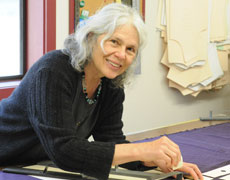High prices: Do they make sustainable clothing a more serious buy?
Posted by Rose on 21st May 2020
In seeking ethical clothing options, can expensive clothes be the cure?
Our silk Kalemkari scarf is hand painted with organic dyes. Most of our scarf collection is one-of-a-kind.
There have been quite a lot of stories in media lately identifying impulse shopping as one way we respond to anxiety. While the pandemic has undoubtedly helped to amplify that phenomenon, it seems anxiety shopping has been around long before COVID-19—even in the "prehistoric" times before the Internet. The rise of suburban malls was accompanied by the phenomenon of impulse-shopping for cheap fashions. Going to the mall was a form of entertainment for many. The arrival of e-commerce has accelerated that process as have global fast-fashion brands such as H&M and Forever 21. Shopping as an entertainment and anxiety-reduction strategy has been fueled by fast fashion.
Fashion writer Marc Bain offers a provocative way to curb impulse shopping. In his Atlantic article, "The Case for Expensive Clothes,” he proposes we limit our apparel shopping to garments that carry a steep enough price tag to cause us to truly ponder the purchase. Setting the bar at $150, Bain says will cause us to pause and consider just how much we truly want and need this garment.
As he concedes later in the article, Bain doesn’t always clear the $150 bar with all his own clothes purchases, but by focusing on quality and utility while deemphasizing low prices, he is impelled to see his clothes acquisitions as investments.
This silk crepe scarf is handpainted in irregular green and blue splashes of color. Most of the scarves in our collection are one of a kind.
Research has shown that we consumers unconsciously weigh the pleasure of acquiring a new thing against the pain of that item’s cost. So it follows that cheap fashions with their inherently low cost/pain factor have become disconnected with our real clothing needs.
Conversely, when faced with a “painful” price, we likely will take a step back and consider more carefully before taking the plunge. Is the fit good? Will I wear it often? Will it work with the rest of my wardrobe? Is it a classic shape that’ll withstand fads? Is it really well made? As Marc Bain puts it, the aim is to not just buy less, but also buy better.
Most of our scarves and wraps are one of a kind like the woolen floral and stripe wrap above.
But Bain qualifies his advice by noting that a substantial price tag doesn’t necessarily guarantee the garment’s production has been exploitation-free. As I’ve written about recently, the lack of transparency in the supply chains of clothing makers continues to be a real challenge for consumers trying to do the right thing. Until there’s greater transparency about how our textiles and clothes are made, shopping carefully and consciously can still make a difference.
Share:





